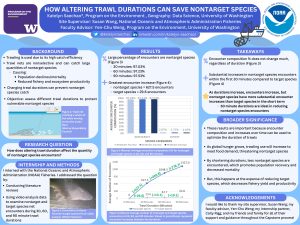HOW ALTERING TRAWL DURATIONS CAN SAVE NONTARGET SPECIES
The growing population and subsequent rise in food demand have resulted in a heavier reliance on fisheries and trawling. Trawling in fisheries has grown because it is efficient at catching fish by simply dragging a large net across the sea floor. However, trawl nets are nonselective, meaning unintended species can also be caught. This increases the risk of overharvesting and death for unintended species while reducing the chances for target species to be caught due to bycatch quotas. The purpose of this study was to determine ideal trawl durations that decrease nontarget species catch. To address this, I interned with the National Oceanic and Atmospheric Administration (NOAA) Fisheries and analyzed video footage from trawl net cameras to identify how species interact with the net. My observations were recorded in a datasheet where I noted information about the species, number of species encountered, and behaviors exhibited. The findings suggest that as trawl durations increase, nontarget species encounters increase substantially, whereas target species encounters experience a slight increase in comparison. Additionally, the findings suggest that short 30-minute durations could reduce nontarget species bycatch, but less target species might be caught as well. By shortening trawl durations, fewer nontarget and target species are caught, which supports the protection of nontarget species. But this may prevent target species catch from meeting food demand. Therefore, the use of shorter trawl durations in combination with other mitigation strategies must be considered and assessed to achieve the goals of minimizing nontarget species and maximizing target species catch.
